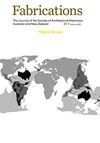Contested Space Revisited: George Town, Penang Before and After UNESCO World Heritage Listing
IF 0.3
0 ARCHITECTURE
Fabrications-The Journal of the Society of Architectural Historians Australia and New Zealand
Pub Date : 2021-05-04
DOI:10.1080/10331867.2021.1930920
引用次数: 0
Abstract
back on its pre-war “pioneers of modernism,” lamenting the leading position that Austrian modernist architecture had lost after the war. According to Plazter, what happened following the occupational period and after CIAM Austria disbanded “still waits appraisal” from future scholars. At the very end, Platzer briefly mentions Hans Hollein, a young architect at the time and a key transitional figure in Austrian architecture between the occupational period and present day. Hollein is the figure who could either complete or break the arc of the “Austrian identity construct” in the twentieth century. While Platzer richly furnishes the post-war milieu with abundant material and detailed analysis, her discussion ends anticlimactically. She eschews postoccupational developments (in which Hollein played a central role) that have since restored Austria’s leading position in the global architectural discourse, demonstrated by contemporary practices such as Coop Himmelb(l)au and the rise to international prominence of the University of Applied Arts Vienna and the University of Innsbruck over the past thirty years. Platzer gestures towards some open questions in the field of architectural history, such as: what is the legacy of the “Austrian identity construct” in architecture today? To what extent is it linked to its pre-war “pioneers of modernism”? The effects of the occupational period for the “Austrian identity construct” in the twentieth century have yet to be explicated. Above all, Platzer has established solid historical ground for scholars to pursue these questions. It is now incumbent upon future scholars to draw out the larger threads that extend across the twentieth century, from Wagner and Loos to post-occupational and contemporary practices, including those of Hans Hollein and Coop Himmelb(l)au.重访竞争空间:联合国教科文组织世界遗产名录前后的槟城乔治镇
回到战前的“现代主义先驱”,哀叹奥地利现代主义建筑在战后失去了领导地位。根据Plazter的说法,占领时期和奥地利CIAM解散后发生的事情“仍有待未来学者的评估”。在最后,Platzer简要地提到了Hans Hollein,他是当时一位年轻的建筑师,也是奥地利建筑从占领时期到现在的关键过渡人物。霍莱因是一个既可以完成也可以打破20世纪“奥地利身份结构”弧线的人物。虽然普拉泽用丰富的材料和详细的分析丰富了战后的环境,但她的讨论却以虎头收尾。她避开了职业后的发展(Hollein在其中发挥了核心作用),这些发展已经恢复了奥地利在全球建筑话语中的领先地位,当代实践如Coop Himmelb(l)au以及维也纳应用艺术大学和因斯布鲁克大学在过去三十年中的国际地位。普拉泽提出了建筑史领域的一些开放性问题,例如:“奥地利身份结构”在今天的建筑中留下了什么遗产?它在多大程度上与战前的“现代主义先驱”有联系?占领时期对20世纪“奥地利身份结构”的影响尚未得到阐明。最重要的是,普拉泽为学者们探究这些问题奠定了坚实的历史基础。现在,未来的学者有责任找出贯穿20世纪的更大的线索,从瓦格纳和卢斯到后职业和当代的实践,包括汉斯·霍莱因和库普·希梅尔布(1)au的实践。
本文章由计算机程序翻译,如有差异,请以英文原文为准。
求助全文
约1分钟内获得全文
求助全文
来源期刊

CiteScore
0.50
自引率
25.00%
发文量
26
 求助内容:
求助内容: 应助结果提醒方式:
应助结果提醒方式:


